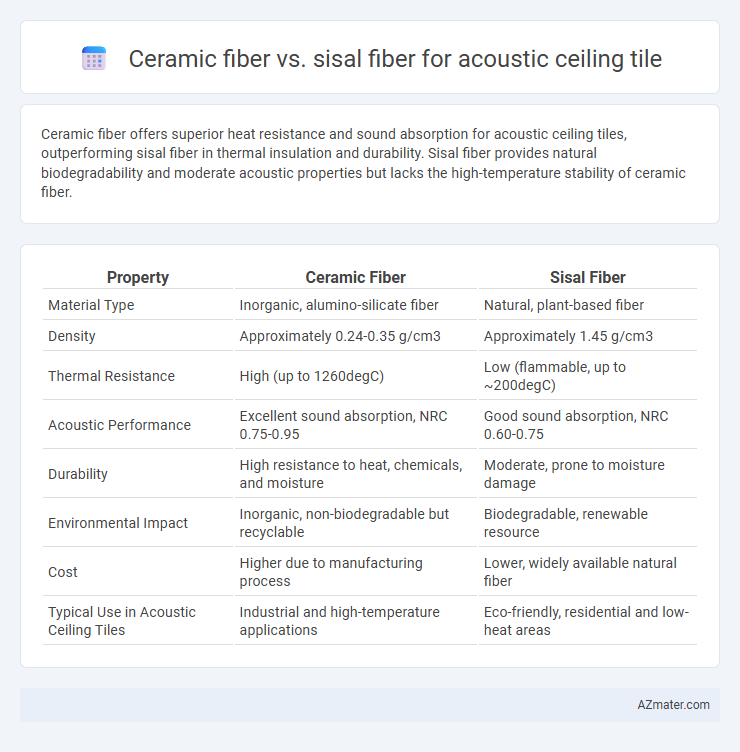Ceramic fiber offers superior heat resistance and sound absorption for acoustic ceiling tiles, outperforming sisal fiber in thermal insulation and durability. Sisal fiber provides natural biodegradability and moderate acoustic properties but lacks the high-temperature stability of ceramic fiber.
Table of Comparison
| Property | Ceramic Fiber | Sisal Fiber |
|---|---|---|
| Material Type | Inorganic, alumino-silicate fiber | Natural, plant-based fiber |
| Density | Approximately 0.24-0.35 g/cm3 | Approximately 1.45 g/cm3 |
| Thermal Resistance | High (up to 1260degC) | Low (flammable, up to ~200degC) |
| Acoustic Performance | Excellent sound absorption, NRC 0.75-0.95 | Good sound absorption, NRC 0.60-0.75 |
| Durability | High resistance to heat, chemicals, and moisture | Moderate, prone to moisture damage |
| Environmental Impact | Inorganic, non-biodegradable but recyclable | Biodegradable, renewable resource |
| Cost | Higher due to manufacturing process | Lower, widely available natural fiber |
| Typical Use in Acoustic Ceiling Tiles | Industrial and high-temperature applications | Eco-friendly, residential and low-heat areas |
Introduction to Acoustic Ceiling Tiles
Acoustic ceiling tiles significantly enhance sound absorption and reduce noise in various environments, with material choice playing a crucial role in performance. Ceramic fiber offers superior thermal insulation and high-temperature resistance, making it ideal for industrial or high-heat settings. Sisal fiber provides natural, sustainable sound absorption with eco-friendly benefits, favored in residential and commercial acoustic applications for its texture and biodegradability.
Overview of Ceramic Fiber
Ceramic fiber is a high-temperature resistant material commonly used in acoustic ceiling tiles for its excellent thermal insulation and sound absorption properties. It offers superior durability, chemical stability, and fire resistance compared to natural fibers like sisal, making it suitable for environments requiring both acoustic performance and safety. Ceramic fiber tiles effectively reduce noise levels by trapping sound waves, contributing to improved indoor acoustics in commercial and industrial settings.
Overview of Sisal Fiber
Sisal fiber, derived from the leaves of the Agave sisalana plant, offers durability and natural sound absorption properties ideal for acoustic ceiling tiles. Its coarse texture and high tensile strength contribute to effective noise reduction and improved indoor air quality by being biodegradable and resistant to mold. Compared to ceramic fiber, sisal fiber provides an eco-friendly, sustainable option with excellent thermal insulation and moisture resistance in ceiling applications.
Acoustic Performance Comparison
Ceramic fiber exhibits superior sound absorption coefficients, particularly in mid to high-frequency ranges, making it highly effective for acoustic ceiling tiles aimed at reducing echo and reverberation. Sisal fiber, while offering moderate sound insulation, performs better in low-frequency absorption due to its natural porous structure but generally yields lower overall Noise Reduction Coefficient (NRC) values compared to ceramic fiber. The enhanced thermal stability and finer fiber diameter of ceramic fiber contribute to its higher sound attenuation efficiency in commercial and industrial acoustic ceiling applications.
Fire Resistance and Safety
Ceramic fiber exhibits superior fire resistance compared to sisal fiber, withstanding temperatures up to 1260degC, making it ideal for acoustic ceiling tiles in high-risk fire environments. Sisal fiber, a natural material, offers moderate fire resistance but is more prone to combustion and produces smoke when exposed to flames. Fire safety standards favor ceramic fiber for acoustic applications requiring enhanced thermal stability and minimal toxic emissions during fire incidents.
Thermal Insulation Properties
Ceramic fiber offers superior thermal insulation properties for acoustic ceiling tiles with a high temperature resistance up to 1260degC, making it ideal for environments requiring heat protection. Sisal fiber provides moderate thermal insulation but has a lower temperature tolerance, typically up to 150degC, limiting its use in high-heat applications. The low thermal conductivity of ceramic fiber significantly enhances energy efficiency, whereas sisal fiber is more suited to environmentally-friendly, low-cost thermal insulation needs.
Environmental Impact and Sustainability
Ceramic fiber used in acoustic ceiling tiles is typically made from inorganic materials with high thermal resistance and low VOC emissions, offering durability but involving energy-intensive manufacturing processes and limited recyclability. Sisal fiber, a natural and biodegradable material derived from agave plants, provides excellent sustainability benefits due to its renewable sourcing, low environmental footprint, and compostability after use. When prioritizing environmental impact, sisal fiber ceiling tiles outperform ceramic fiber by promoting a circular lifecycle and reducing dependence on synthetic, non-renewable resources.
Installation and Maintenance Considerations
Ceramic fiber acoustic ceiling tiles require careful handling due to their brittleness and potential health risks from fibers, necessitating protective gear during installation and routine air quality checks during maintenance. Sisal fiber tiles offer easier installation with flexibility and natural resilience, making them less prone to damage and simpler to clean using standard vacuuming methods. Maintenance for ceramic fiber focuses on avoiding fiber release and deterioration, while sisal fiber demands periodic inspection for moisture damage, given its organic composition.
Cost and Availability
Ceramic fiber acoustic ceiling tiles tend to have higher upfront costs due to advanced manufacturing processes and superior heat resistance properties, whereas sisal fiber tiles offer a more budget-friendly option with moderate acoustic performance. Sisal fiber is more readily available in regions with abundant natural fiber supply chains, contributing to lower procurement expenses compared to ceramic fiber, which relies on specialized production and may face limited availability. Evaluating total cost of ownership considers sisal fiber's cost-effectiveness and ease of sourcing against ceramic fiber's durability and fire retardant advantages.
Conclusion: Choosing the Right Fiber for Acoustic Ceiling Tiles
Ceramic fiber offers superior thermal resistance and durability, making it ideal for high-temperature environments and long-lasting acoustic ceiling tiles. Sisal fiber provides natural sound absorption with eco-friendly properties, suitable for sustainable building projects prioritizing environmental impact. Selecting the right fiber depends on balancing acoustic performance, environmental considerations, and specific installation requirements for ceiling tile applications.

Infographic: Ceramic fiber vs Sisal fiber for Acoustic ceiling tile
 azmater.com
azmater.com